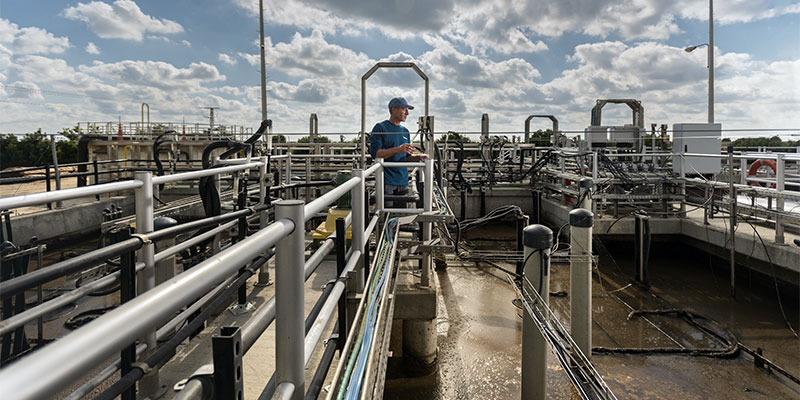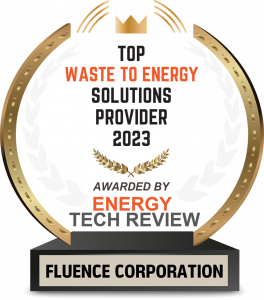
Biological wastewater treatment — which relies on microorganisms to break down organic waste — has a long history, and ranges from simple cesspits to conventional activated sludge plants all the way to technologically advanced solutions like MABR.
Biological wastewater treatment harnesses the action of bacteria and other microorganisms to clean water
Biological wastewater treatment is a process that seems simple on the surface since it uses natural processes to help with the decomposition of organic substances, but in fact, it’s a complex, not completely understood process at the intersection of biology and biochemistry.
Biological treatments rely on bacteria, nematodes, or other small organisms to break down organic wastes using normal cellular processes. Wastewater typically contains a buffet of organic matter, such as garbage, wastes, and partially digested foods. It also may contain pathogenic organisms, heavy metals, and toxins.
The goal of biological wastewater treatment is to create a system in which the results of decomposition are easily collected for proper disposal. Biological treatment is used worldwide because it’s effective and more economical than many mechanical or chemical processes.
Biological treatment usually is divided into aerobic and anaerobic processes. “Aerobic” refers to a process in which oxygen is present, while “anaerobic” describes a biological process in which oxygen is absent. Scientists have been able to control and refine both aerobic and anaerobic biological processes to achieve the optimal removal of organic substances from wastewater.
Biological wastewater treatment often is used as a secondary treatment process to remove material remaining after primary treatment with processes including dissolved air flotation (DAF). In the primary water treatment process, sediments and substances such as oil are removed from the wastewater.
Aerobic Wastewater Treatment
Aerobic wastewater treatment processes include simple septic or aerobic tanks, and oxidation ditches; surface and spray aeration; activated sludge; oxidation ditches, trickling filters; pond and lagoon-based treatments; and aerobic digestion. Constructed wetlands and various types of filtration are also considered biological treatment processes. Diffused aeration systems may be used to maximize oxygen transfer and minimize odors as the wastewater is treated. Aeration provides oxygen to the helpful bacteria and other organisms as they decompose organic substances in the wastewater.
A time-honored example of an aerobic biological treatment method is the activated sludge process, which is widely used for the secondary treatment of both domestic and industrial wastewater. It is well suited for treating waste streams high in organic or biodegradable content and is often used to treat municipal sewage; wastewater generated by pulp and paper mills or food-related industries such as meat processing; and industrial waste streams containing carbon molecules.
MABR Treatment
In recent years, technological advances have been transforming biological processes. One example is the membrane aerated biofilm reactor (MABR), which refines this process to use 90% less energy for aeration, typically the most energy-intensive stage of traditional biological treatment. In Fluence’s MABR treatment, air at atmospheric pressure is gently blown into a spirally wound membrane in a tank, with air on one side of the membrane and mixed liquor on the other in a single tank. Nitrification-denitrification is achieved by a biofilm that forms on the membrane. The result is an effluent suitable for irrigation or release into the environment.
Most legacy plants around the world use activated sludge treatment or other older aerobic treatment processes. Such plants are time-consuming and expensive to replace, or don’t have necessary space for expansion. To address this need, Fluence has created SUBRE MABR modules. SUBRE submerges arrays of MABR membranes in existing wastewater treatment plant tanks to increase energy efficiency, capacity, and effluent quality — all on the plant’s existing footprint.
Fluence has also packaged complete Aspiral™ MABR wastewater treatment plants inside standard shipping containers, which allows efficient transportation and fast commissioning in virtually any region. The plug-and-play units can be used in tandem to increase capacity, and are designed for low maintenance and remote monitoring.
In just a few years, MABR has developed into a mature technology, with extensive projects underway in China in compliance with the country’s strict Class 1A effluent standards. In the United States, Fluence MABR proved itself in compliance with California Title 22 effluent standards during a yearlong demonstration at Stanford University.
Anaerobic Treatment
In contrast, anaerobic treatment uses bacteria to help organic material deteriorate in an oxygen-free environment. Lagoons and septic tanks may use anaerobic processes, but the best-known anaerobic treatment is anaerobic digestion, which is used for treating effluent from food and beverage manufacturing, as well as municipal wastewater, chemical effluent, and agricultural waste.
Anaerobic digestion drives one of the most robust areas of resource recovery: energy recovery. In this form of energy recovery, also known as waste-to-energy, anaerobic digestion is used to produce biogas, which is composed primarily of methane. Operators can use it to generate energy to help fuel operations on the way to become energy net zero, or even turn waste streams into revenue streams.
Further Treatment
The type of biological treatment selected for wastewater treatment, whether aerobic or anaerobic, depends on a wide range of factors, including compliance with environmental discharge quality regulations.
Biological treatments often are supplemented with additional treatment stages, including chlorination and UV treatment, as well as a range of filtration options including carbon filtration, reverse osmosis, and ultrafiltration.
Researchers continue to look for ways to optimize conventional biological wastewater treatment. In one example, Finnish researchers added iron sulfate to wastewater before biological treatment to reduce phosphorous in tough-to-treat pulp mill wastewater. Other researchers have used UV light to remove challenging substances such as chemical residues and pharmaceutical compounds. And, MABR’s groundbreaking aeration model saves so much energy that it makes treatment possible in remote areas on alternative energy sources.
So, while biological treatment has a long history, it’s continuing to evolve in ways that make it more effective, efficient, and available. Contact Fluence for information on our MABR products or to take advantage of our 30 years of experience in waste-to-energy solutions.

